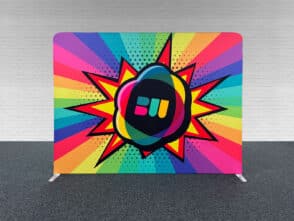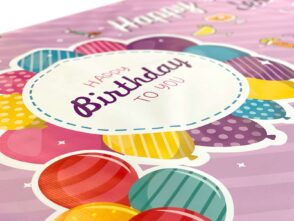Outdoor banners capture attention and promote events, businesses, and various occasions. Ensuring the longevity of these promotional materials is essential for cost-effective advertising and maintaining high-quality graphics. This article is the ultimate guide to outdoor banner longevity, providing tips and best practices for increasing their lifespan, including UV-resistant materials, proper installation techniques, and maintenance.
One of the primary factors determining the lifespan of outdoor banners is the type of material used. The best material for outdoor banners is typically vinyl (PVC) due to its durability, affordability, and resistance to weather, water, and humidity. Selecting UV-resistant materials and high-quality inks can significantly reduce sun exposure and fading effects, prolonging the banner’s life. Proper installation using bungee cords, ropes, or zip ties can also secure the banner and minimise the impact of wind and other weather conditions.
Maintenance plays a crucial part in extending the lifespan of outdoor banners. To achieve this, regular cleaning and proper storage are essential. Additionally, storing the banners in a dry space with moderate temperature when not in use is crucial, as harsh temperatures and humidity can decrease the banner’s lifespan. By following these best practices, businesses and individuals can capitalise on the long-lasting impact of their outdoor banners.
Materials for Outdoor Banners
Choosing the right material for your outdoor banner is essential for achieving a long-lasting, high-quality display. There are several materials available that cater to different requirements and environments. In this section, we will discuss three common materials used for outdoor banners: vinyl, mesh, and fabric.
Vinyl Banners
Vinyl banners are a popular choice for outdoor displays due to their durability and affordability. A typical high-quality vinyl banner material is available in 510 gsm. Heavier materials, such as 650gsm., provide greater durability and are more suitable for extended outdoor use. Vinyl is weatherproof and resistant to water, humidity, and UV rays, making it an excellent choice if your banner will be exposed to harsh weather conditions.
Reinforced hem and eyelets can also increase the lifespan of a vinyl banner. For instance, using hemmed edges and eyelets allows for secure attachment and reduces the chances of tearing or fraying. Additionally, placing the banner away from direct sunlight and heavy winds will help preserve its quality over time.
Mesh Banners
Mesh banners are another great option for outdoor displays, particularly in windy locations. The material with small perforations means mesh banners offer increased wind resistance, reducing the chance of damage caused by strong gusts. They retain a high-quality appearance and hold up well against various weather elements such as snow, rain, and ice.
Although mesh banners provide greater wind resistance than standard vinyl banners, proper installation and care are essential for longevity. Use proper hanging techniques, such as reinforced edges and secure attachments, to ensure the banner stays in place during adverse weather conditions.
Fabric Banners
While fabric banners are generally considered more suitable for indoor displays, they can be used outdoors. Fabric banners are lightweight polyester, making them portable and easy to display. However, there may be better options for extended outdoor use, particularly if exposed to harsh weather conditions or direct sunlight. To increase the longevity of a fabric banner, choose a location that offers some protection from the elements and avoid using them in areas prone to strong winds or heavy rain.
In conclusion, the materials you choose for your outdoor banner directly impact its durability and longevity. Consider the specific needs and conditions of your display location when choosing between vinyl, mesh, or fabric banners, and ensure proper installation and maintenance to maximise the lifespan of your outdoor banner.
Proper Installation Techniques
Installing outdoor banners the right way is essential for maximising their longevity. Proper installation techniques can protect banners from harsh environments and prevent wind damage. This section discusses three common installation methods: Hem and eyelets for securing with ropes, bungee cords, and zip ties.
Using Hem and eyelets
Eyelets are metal rings placed around the banner’s edges to reinforce the holes used for hanging. These are essential for hanging banners in outdoor settings, as they prevent the banner material from tearing under tension. To install a banner using eyelets, ensure they are evenly spaced along its edges. Then, attach bungee chords or zip ties to the eyelets and secure them to your chosen display structure. This method keeps the banner taught and prevents it from sagging, resulting in a visually appealing and durable display.
Securing with Ropes, Bungee Cords, and Zip Ties
Ropes, bungee cords, and zip ties are practical solutions to secure banners to various structures. When securing a banner with ropes, it’s essential to use sturdy materials that can withstand outdoor elements. Wrap the ropes around the banner’s eyelets and tie them to the display structure, ensuring the banner remains straight and even.
For bungee cords or zip ties, loop them through the eyelets and attach them to the structure, maintaining tension in the banner to prevent wrinkles and sagging. These materials offer flexibility in the installation, allowing the banner to move slightly during windy conditions without detaching from the display structure.
Preventing Wind Damage
One of the main challenges when displaying banners outdoors is wind damage. To minimise the risk of damage in windy environments, consider using mesh banners that allow wind to pass through the material, reducing harmful strain on the banner.
Another effective method to prevent wind damage is installing wind slits – small semi-circle cuts made in the banner material – that allow air to flow through and reduce stress on the banner. However, this may affect the banner’s visual appeal, so consider when and where to implement wind slits. If you require wind slits on your banner, please leave us a note in the notes section.
Maintenance and Care Tips
Maintaining and caring for outdoor banners can significantly extend their lifespan. This section provides helpful tips on cleaning, storing, and checking for damage to keep your banners looking fresh and engaging.
Cleaning Outdoor Banners
Regular cleaning helps maintain the appearance and durability of your banners. Use a solution of mild dish soap and lukewarm water to clean the vinyl banners’ surface gently. Avoid abrasive materials, such as power washers or scrub brushes, as they may damage the print. Instead, gently use a soft cloth or towel to clean the surface, and remember to wear gloves while cleaning. Rinse the banner thoroughly with clean water and let it dry completely before storing or re-using it. This simple and affordable cleaning method can prolong the life of your banners, keeping them vibrant and weatherproof.
Storing Banners Correctly
Proper storage is essential to keep your banners in good condition for future use. When not in use, make sure to roll up your banner, taking care to avoid creasing the material. Creases can cause damage to the print and reduce the overall longevity of the banner. Store rolled banners in a cool, dry place, away from direct sunlight and extreme temperatures. Please keep them in protective tubes or containers to prevent accidental damage or dust buildup.
Positioning for Minimum Sunlight Exposure
Direct sunlight can greatly affect the lifespan of outdoor signage. Place banners where they receive minimum direct sunlight to reduce the impact of sunlight exposure. Be mindful of the shading provided by nearby buildings and trees.
Monitoring Weather Conditions
Outdoor banners need to be secured properly to withstand various weather conditions, as the wind can especially cause rips, tears, and separation of the component elements of the banner. Regularly check the weather forecast and take preventive measures like removing banners during extreme weather conditions or securing them more tightly. A properly taut installation will help protect the banner against extreme wind gusts and the general flag effect.
Incorporating these tips and best practices will help extend the lifespan of outdoor banners, ensuring their durability and effectiveness for promotion and attracting attention.
Choosing the Right Banner for Your Needs
To maximise the lifespan of your outdoor banners, selecting the right banner for your specific needs is crucial.
Assessing the Purpose and Occasion
Before choosing a banner, consider its intended purpose and the occasion it will be used for. Is it meant to promote a school event, engage local community members, or attract customers to your business? Identifying the primary goal of your banner is essential in selecting the proper size, material, and design elements. Outdoor banners should be designed to withstand various weather conditions and effectively convey your message for the intended occasion.
Conclusion
In conclusion, outdoor banner longevity is essential for cost-effective marketing and maintaining your business’s professional appearance. Several factors can significantly impact an outdoor banner’s lifespan, such as the material used and the banner’s installation and maintenance. By following best practices, it is possible to increase the longevity of your outdoor banners and make them work for you for years to come.
Firstly, choosing a high-quality, weather-resistant material is crucial for outdoor banner durability. Vinyl (PVC) is typically the best choice, as it is durable, affordable, and resistant to weather, water, and humidity. Thicker materials, such as 510 gsm PVC, provide even greater outdoor durability with a longer lifespan.
Proper installation is another critical factor in outdoor banner longevity. The best way to protect banners from extreme wind gusts or the general flag effect is to ensure the material is taut. Keeping the material pulled tight helps provide better resistance against the force of the wind.
You can enjoy a cost-effective, visually-appealing marketing solution by selecting the right materials, properly installing your banners, and maintaining them regularly.









Leave a Reply
You must be logged in to post a comment.